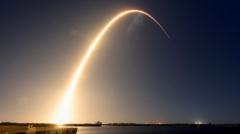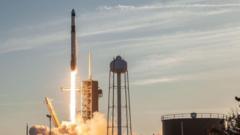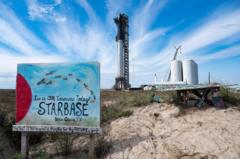On Wednesday, a SpaceX Falcon 9 rocket successfully launched two lunar landers from the Kennedy Space Center, aiming to expand our understanding of the Moon through commercial efforts.
Lunar Ventures: SpaceX Launches Private Missions to the Moon

Lunar Ventures: SpaceX Launches Private Missions to the Moon
Two lunar landers from US and Japan begin their journey to explore the Moon, marking a milestone in commercial space exploration.
SpaceX has taken a significant step in commercial space exploration by launching two lunar landers aboard its Falcon 9 rocket. The launch occurred early Wednesday morning at 01:09 local time from the Kennedy Space Center in Florida. This mission involves the collaboration of American company Firefly Aerospace and Japan's ispace, reflecting the rising trend of private companies venturing into lunar exploration.
The two landers will separate once they reach the Moon's orbit and will conduct individual exploration missions. Firefly's rover, named Blue Space, is expected to take approximately 45 days to arrive at the Moon. Upon landing, Blue Space plans to perform various tasks, including drilling for samples and capturing X-ray images to study the Earth's magnetic field, with the goal of advancing future human missions on the lunar surface and improving our understanding of how space weather affects Earth.
On the other side, ispace's Resilience lander, which is set to take up to five months to reach the Moon's surface, has plans to deploy a rover that will explore the lunar terrain and collect loose surface material known as regolith. This mission has received NASA’s backing and, if successful, it would represent NASA's largest commercial delivery mission to the Moon to date.
Previously, Intuitive Machines set a benchmark by becoming the first commercial entity to place a lander on the Moon, a feat historically achieved only by a select few countries including the US, Russia, China, India, and Japan.
In a related development, SpaceX is also preparing for its seventh orbital flight test of the Starship rocket, which is scheduled to take off from Texas later on Wednesday at 16:00 local time. With these ambitious projects underway, the scope of commercial exploration of space, particularly the Moon, is rapidly evolving and promises to unveil new frontiers for humanity.
The two landers will separate once they reach the Moon's orbit and will conduct individual exploration missions. Firefly's rover, named Blue Space, is expected to take approximately 45 days to arrive at the Moon. Upon landing, Blue Space plans to perform various tasks, including drilling for samples and capturing X-ray images to study the Earth's magnetic field, with the goal of advancing future human missions on the lunar surface and improving our understanding of how space weather affects Earth.
On the other side, ispace's Resilience lander, which is set to take up to five months to reach the Moon's surface, has plans to deploy a rover that will explore the lunar terrain and collect loose surface material known as regolith. This mission has received NASA’s backing and, if successful, it would represent NASA's largest commercial delivery mission to the Moon to date.
Previously, Intuitive Machines set a benchmark by becoming the first commercial entity to place a lander on the Moon, a feat historically achieved only by a select few countries including the US, Russia, China, India, and Japan.
In a related development, SpaceX is also preparing for its seventh orbital flight test of the Starship rocket, which is scheduled to take off from Texas later on Wednesday at 16:00 local time. With these ambitious projects underway, the scope of commercial exploration of space, particularly the Moon, is rapidly evolving and promises to unveil new frontiers for humanity.


















